Contents
Growing tomatoes in hydroponics at home is quite realistic and within the power of all attentive gardeners who are not afraid of difficulties. Due to the fact that the crop has a shallow root system, it is perfectly cultivated in a soilless artificial system and, with proper planting and care, brings a good harvest.
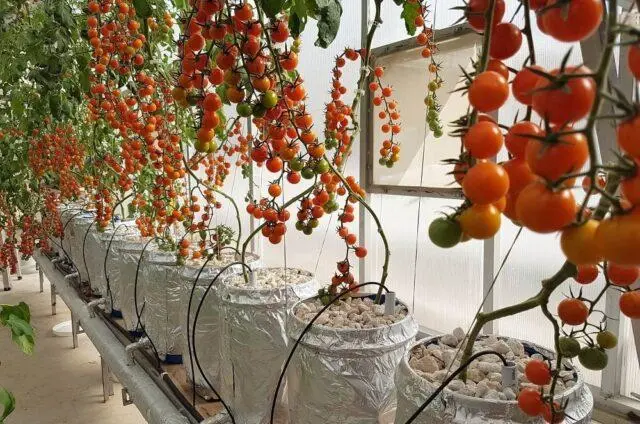
When growing tomatoes in hydroponics, it is possible to regulate the development and growth of the plant
Varieties of tomatoes for hydroponics
Before starting work, you should choose the variety of tomatoes that will be cultivated. Not every variety of vegetable can be grown in hydroponics, so the choice should be taken carefully. It is best for this technology to give preference to undersized options, it will be much more convenient to care for them. Varieties such as Druzhok, Gavrosh, Early Bird, Bon Appetit, Crane, Alaska, Geronimo, Favorit are considered the most suitable. Cherry tomatoes are also grown hydroponically. In this case, the bushes should be pinched when they reach a height of 100-120 cm.
The advantages and disadvantages of the method
The technology of growing tomatoes at home in hydroponics has a number of advantages and disadvantages that should be considered when choosing this method.
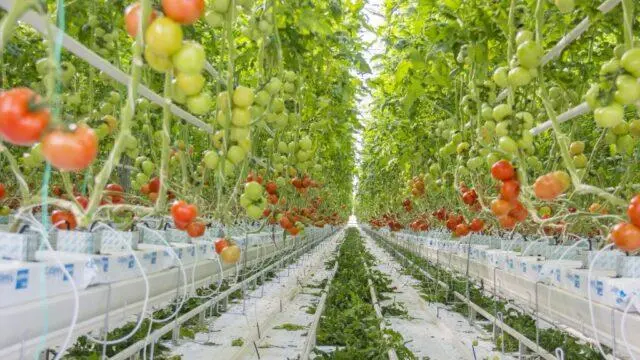
You can grow tomatoes in hydroponics both from seedlings and from seeds.
Advantages:
- high yield;
- excellent fruit quality;
- easy care;
- minimal risks of diseases and pest attacks;
- reducing the cost of fertilizer and water.
Disadvantages:
- obligatory observance of all the rules of planting and growing;
- the complexity and complexity of the process;
- high initial costs for the necessary materials and equipment.
hydroponics tomato yield
Hydroponically grown tomatoes produce more yields than conventionally grown tomatoes. But it should be noted that the number of fruits is strongly influenced by the correct fulfillment of all conditions, compliance with the requirements of agricultural technology and the quality of care. Also, the amount of harvest directly depends on the selected variety of tomatoes. On average, according to experienced gardeners, with proper care, it is possible to collect about 3 kg of tomatoes from one healthy stunted bush, and up to 14 kg per square meter of greenhouse per month.
Conditions for growing tomatoes in hydroponics
In order for the crop to be harvested, the plantings need to provide suitable conditions, as well as organize proper care. In addition, you should pick up equipment and make a special nutrient solution. Place tomatoes suitable for hydroponics in a greenhouse, grow tent or grow box.
The temperature in the place where the crop is grown during its growth should be maintained within + 22-24 ° C during the day, up to + 16-18 C at night, at the time of setting and ripening of tomatoes + 25-28 and + 18-20 ° C.
Since the plant has a strong sensitivity to the length of daylight hours, it needs to provide sufficient light for at least 18 hours a day. At the time of fruit formation, daylight hours can be reduced to 17 hours.
The technology of growing tomatoes in hydroponics
Beginning to grow tomatoes in hydroponics should be gardeners with some experience. This process is painstaking and difficult enough for a beginner.
The technology consists of a number of procedures:
- Planting tomato seeds in corks.
- Transplantation of sprouts at two weeks of age into cubes.
- Assembly and installation of the system.
- Transplantation (after three weeks) into the system.
- Organization of careful aftercare.
How to grow tomatoes hydroponically
If the gardener has decided to start growing tomatoes in hydroponics, then for this he will need certain materials. You can buy them at garden centers and specialized stores or make your own. The technology can be used both at home and indoors.
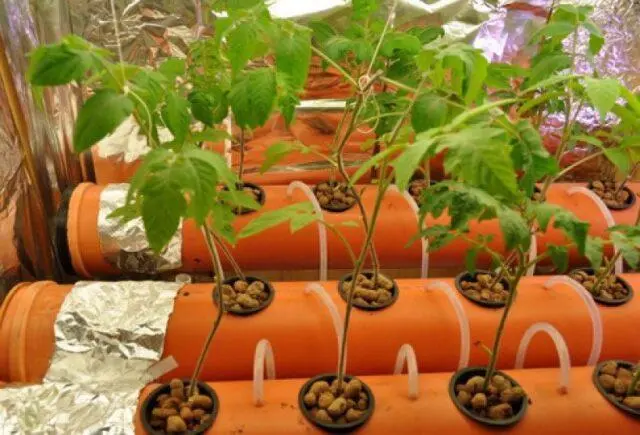
In hydroponics, tomatoes do not come into contact with the soil and are less likely to get sick
Necessary materials
To grow tomatoes in hydroponics, you will need equipment (water level meter, scales, conductivity indicator), seeds, nutrient solution or elements for its preparation, substrate. To build a system, you need containers of different sizes, which are larger on the outside than on the inside.
System assembly
Plants for hydroponics tomatoes are sold in stores ready-made, but it is cheaper to make them yourself. To do this, take containers with a height of 15 to 20 cm and make drainage holes at their bottom to remove excess moisture. Next, install them in boxes or pots of larger diameter and height. Opposite each inner container, holes are made that are slightly smaller in diameter than its bottom, to eliminate excess nutrient solution.
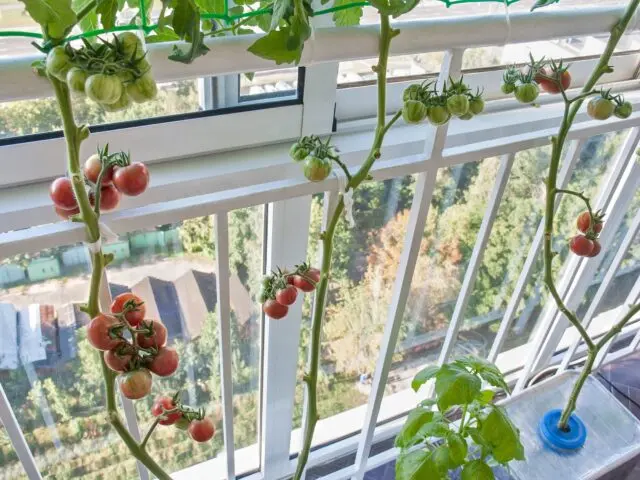
Excess nutrient fluid can be reused
How to prepare a hydroponics solution for tomatoes
A solution for tomato hydroponics is prepared by hand or purchased in stores. There are several types of it, preference is given, starting from the variety of culture.
To prepare a solution for tomato hydroponics with your own hands, you can use the step-by-step instructions:
- Weigh each necessary element as accurately as possible and scatter in separate containers.
- Fill containers with a little water.
- Wait for the elements to dissolve.
- Alternately pour the resulting mixture into the main solution.
- Close the tank tightly and completely isolate the liquid from oxygen.
The optimal ratio of elements for hydroponic tomatoes per 1 liter of water is presented in the table below:
Element | During the growing season | During the flowering period |
P | 120 | 80 |
К | 150 | 280 |
N | 300 | 180 |
microelements | 0,35 | 0,65 |
calcium nitrate | 1,9 | 1,1 |
potassium monophosphate | 0,52 | 0,35 |
magnesium sulfate | 0,5 | 0,5 |
potassium sulphate | — | 0,45 |
Aftercare
The aftercare of hydroponic tomatoes involves a number of steps that are slightly different from those required by plants growing in the ground. The procedure is as follows:
- Control over the development and growth of the root system. It is recommended to constantly monitor the process of root germination to the desired depth. Because as soon as they get to the bottom of the neck, the level of the nutrient solution will need to be lowered. This is done to achieve the formation of an airy and moist layer for the roots.
- Top dressing. The level of the solution should be constantly maintained (by drip irrigation or its daily addition), and the concentration of nutrients in it should be regularly measured with an electrical conductivity indicator and kept at a level of 1,5 to 3 mS. Changes should be checked and recorded every day, and the concentration should not be allowed to fall below the acceptable level. If there is a shortage of certain components, they should be added in the required percentage, or a new solution should be prepared. It is recommended to change it at least once a month.
- Garter. Hydroponic tomatoes need to be tied up in a special way that allows the top of the stem to grow for a long time and form new ovaries. To do this, the rope is wound with a large margin on a hook located on a trellis under the roof of the greenhouse. The end of the lace is lowered to the base of the stem and secured under the leaf with a plastic clip. As the tomato grows, the trunk is wrapped around the rope, cutting off the lower leaves from it. At the moment when the stem is completely bare at the bottom, part of the rope is removed from the hook, and the bare trunk is laid on top of the pot. If the planting of a tomato in hydroponics is two-row, then the garter of the bushes is performed in a V-shape.
- Pasynkovanie. The procedure is carried out periodically. The shoots are removed when their length is about 2 cm. At the same time, a couple of leaves are cut off.
- Pollination. If a tomato grows hydroponically in a greenhouse, then bumblebees are launched into it to pollinate the bushes; at home, the procedure is performed manually, using a brush or an electric toothbrush.
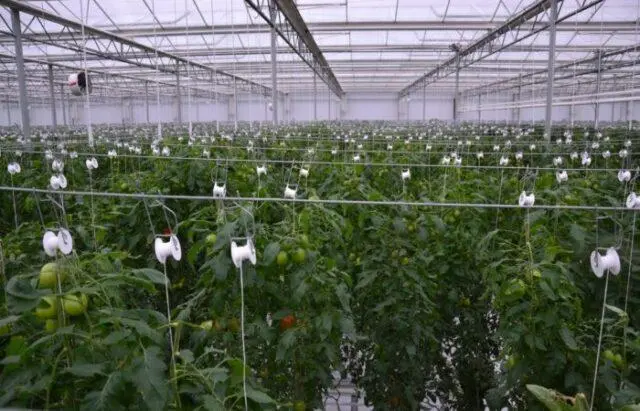
Without pollination, the plant will not bear fruit.
Conclusion
Hydroponic tomatoes at home have recently begun to grow more often. This modern technology allows you to get a high crop yield without the traditional planting of the plant in the ground. There are several options for such cultivation, each of them has its own characteristics and nuances, which should be familiarized with before planting.










